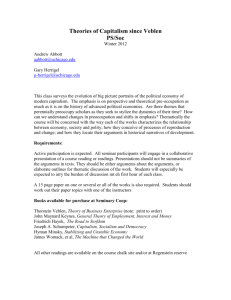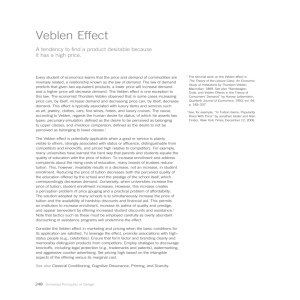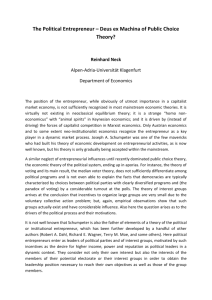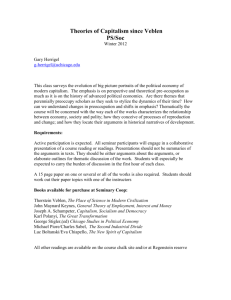Innovation and Society
advertisement
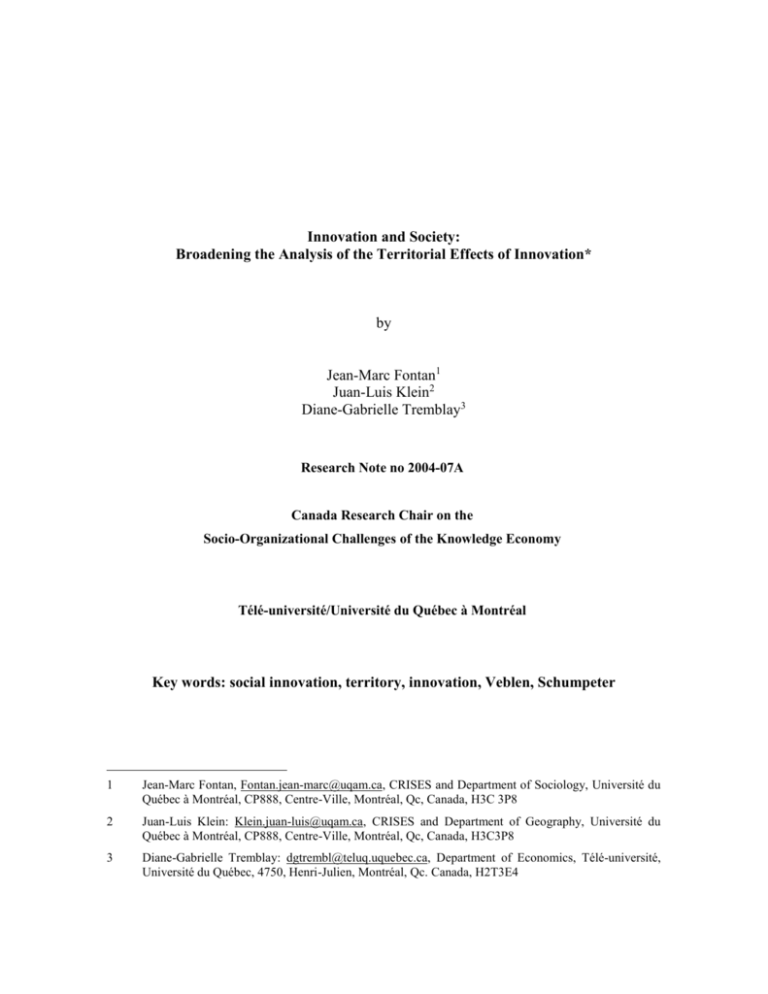
Innovation and Society: Broadening the Analysis of the Territorial Effects of Innovation* by Jean-Marc Fontan1 Juan-Luis Klein2 Diane-Gabrielle Tremblay3 Research Note no 2004-07A Canada Research Chair on the Socio-Organizational Challenges of the Knowledge Economy Télé-université/Université du Québec à Montréal Key words: social innovation, territory, innovation, Veblen, Schumpeter 1 Jean-Marc Fontan, Fontan.jean-marc@uqam.ca, CRISES and Department of Sociology, Université du Québec à Montréal, CP888, Centre-Ville, Montréal, Qc, Canada, H3C 3P8 2 Juan-Luis Klein: Klein.juan-luis@uqam.ca, CRISES and Department of Geography, Université du Québec à Montréal, CP888, Centre-Ville, Montréal, Qc, Canada, H3C3P8 3 Diane-Gabrielle Tremblay: dgtrembl@teluq.uquebec.ca, Department of Economics, Télé-université, Université du Québec, 4750, Henri-Julien, Montréal, Qc. Canada, H2T3E4 p.2 To contact us : Télé-université 4750 Henri Julien, Montréal, Québec, Canada fax : 1-514-843-2160 phone : 1-514-843-2015 email : dgtrembl@teluq.uquebec.ca Biographical note Diane-Gabrielle Tremblay is the Canada Research Chair the Socio-Organizational Challenges of the Knowledge Economy. She is professor and director of research at the Télé-université of the Université du Québec. She is a member of the Committee on Sociology of Work of the International Sociological Association, the Executive Council of the Society for the Advancement of Socio-Economics, as well as cochair of the "social times and working times" committee of the Association internationale des sociologues de langue française. She is also president of the Association d’économie politique and editor of the electronic journal Interventions économiques. Also Co-chair of the Bell Canada Research Chair on Technology and work organization, professeur associé with Ecole nationale d’administration publique and UQAM, she has published many articles and books on employment and types of employment, job training, innovation in the workplace and work organization, as well as the articulation between work and family life. See websites for details: www.teluq.uquebec.ca/chaireecosavoir www.teluq.uquebec.ca/chairebell www.teluq.uquebec.ca/interventionseconomiques www.teluq.uquebec.ca/chaireecosavoir/cvdgt; e-mail : dgtrembl@teluq.uquebec.ca Note: This article has been adapted from a chapter of the book entitled Innovation socioterritoriale et reconversion économique: le cas de Montréal. (L’Harmattan 2004, forthcoming). The authors would like to thank their colleague Norbert Alter for his comments on a preliminary draft of this article. The article is forthcoming in French in October 2004 in the French Journal GÉOGRAPHIE, ÉCONOMIE, SOCIÉTÉ (Paris: Elsevier). p.3 The concept of innovation is usually restricted to the technology or technical field. Until the 1990s, scarcely anybody talked about social innovation except, in certain cases, to refer to the likely effect of society on the emergence of technical innovation. The analysis stopped there. Thus, this article aims to broaden the analysis of innovation by examining its social dimension, a notion that has recently come into use in the trends of “new economic sociology” (Levesque et al. 2001) and “socio-economic geography” (Benko and Lipietz, 2000). From our perspective, innovation is not considered to be the simple mechanical insertion of technical novelty into production. This perspective extends beyond the idea that there is, downstream of the invention, a social usage that is ready or naturally disposed to integrate a technique, a process or a particular type of organization of social relations. We argue that the continuous presence of society must be taken into account throughout the “process of innovation production,” starting with the inventor’s instinct, the different mechanisms leading to its institutionalization, the necessary efforts to construct the social usage of the invention, and ending up with its diffusion. This perspective does not deny the role of the market in the production of innovation, but argues that the latter is embedded in society. It is essential to examine this link in order to understand the different dynamics of development which take place in territories which, while certainly specific, are related to global processes. In this article, our analysis of the role of society in innovation processes consists of an overview, indeed a summary, of the different perspectives developed to study the innovation process. We suggest an approach that will allow us to revisit the different stages marking the evolution of the concept of innovation. The article is divided into four parts. Part One will review the bases laid by Schumpeter and Veblen’s founding analyses while pointing out the lack of a specific examination of innovation by the classical social analysts. Part Two will address innovation from the perspective of evolutionary economists. We will reconstruct an explanation of social innovation as a cognitive process confronted with localized social resistance, thus posing the problem of social and territorial diffusion of innovation. Part Three will focus on the renewal of the concept of innovation, a renewal initiated by authors whose conceptual and methodological framework considers innovation as a social construct with multiple phases and facets. Part Four concludes by emphasizing the strong link between sociality, territoriality and market. We maintain that innovation is a social and territorial construction, whose production and effects depend on local and global socio-economic contexts that are conflict ridden and hierarchical. From this perspective, the territory mediatizes and structures arrangements of production actors, organizations and decision makers, thus allowing for the emergence of specific innovation cultures but that are not isolated from nor independent of more global contexts. p.4 INNOVATION AND SOCIETY: FOUNDING ANALYSES It must first be specified that the works by classical analysts of society and its evolution did not focus much on the notion of innovation. This lack of interest is explained, in our view, by the deterministic and unilinear conception of social change held by these authors. This conception, against which Braudel (1985) rebelled, was held by important authors such as Durkheim, Weber, Spencer and Marx. It was only towards the end of the 19th century that the concept of innovation entered into the language of sociology in a veiled way. This occurred when the notion of “imitation” was used by Tarde (1890) who explained that societies evolve through the daily accumulation of inventions -- “innovations”-- which gradually alter the lot of human behaviour. According to Tarde, the distinctive feature of human beings is to imitate fellow human beings and therefore when a new behaviour appears, it entails an “epidemiological” reaction whereby “the innovation” is imitated as soon as conditions permit. However, Tarde did not dwell on the conditions of this imitation and this vision remained marginal. It was not until the analyses by two trail-blazing authors, namely Schumpeter and Veblen, that a more comprehensive conceptualization of innovative processes emerged. Schumpeter’s entrepreneur-innovator Schumpeter’s main contribution to the analysis of innovation is the entrepreneur- innovator. He borrows his vision of the entrepreneur or business leader from the notion of Führershaft which refers to the fact that in all fields of social activity, the leader has a special role. The abilities of this leader essentially amount to initiative and will. By transposing this notion into the field of economics, Schumpeter derives from it the notion of business and entrepreneur. Business is the act of achieving and the entrepreneur is the agent who carries out new combinations of production factors (Tremblay, 1989). For Schumpeter, the entrepreneur is not the inventor of a discovery but the one who introduces this discovery into the firm, the industry, the economy, that is, strictly speaking, the person responsible for its diffusion. In his view, economic society is run by human decisions, those of entrepreneurs, and not by ideologies or abstract social classes. This is what basically distinguishes Schumpeter’s theory from the deterministic and macro-social perspectives mentioned above. Thus, change stems from the concrete exercise of a function and not from the function per se, which means that when somebody is an “entrepreneur,” it is because he implements new combinations; he creates a context through which the framework of social intervention broadens and is transformed. Only this act of entrepreneurship corresponds to the role and function of an entrepreneur. Schumpeter constructs his analysis in the economic environment and sees an actor-transformer in anybody who can implement a new combination of arrangements in a firm, an organization with an economic vocation. (Tremblay, 1989) p.5 From this perspective, the function of the entrepreneur consists in overcoming a series of obstacles. According to Schumpeter, innovation is a creative response to these obstacles. Three major types of resistance to innovation can be identified. First, the entrepreneurinnovator acts in a context of uncertainty, that is, given the information that he has, he is not sure that his project will be successful. He may use retrospective data, but these bring little certainty since nobody is using them the way he suggests. The second type of obstacle appears to be fairly obvious and was described by Schumpeter in 1935 as follows: “It is objectively more difficult to innovate than to use what is usual and proven.” (translation) Lastly, the third type of obstacle -- in our view, the most important-- involves the reaction of the social milieu to the innovation, or “to anybody who wants to innovate” (Schumpeter, 1935) (translation, quoted in Tremblay, 1989). Thus, Schumpeter said: “It is not enough to produce satisfactory soap, it was also necessary to induce people to wash.”4 This metaphor still applies to the present day since it raises the issue of the social construction of usage of the invention, which is the specific feature of innovation. Although Schumpeter’s works have made it possible to isolate the role of the entrepreneur as a key agent of change in economic organizations, he did not broaden the role of the entrepreneur to other types of actors in the social, political and cultural spheres. To grasp the full complexity of the recognition of usage, the link must be made between Schumpeter and Veblen’s works. Veblen and the role of technology Veblen makes an important contribution to the economic analysis of innovation, but especially to the global and interdisciplinary examination of this subject. For Veblen, just as for Schumpeter, technology or, in his words, “the state of the industrial arts,” is the key and determining economic factor in social evolution. What Veblen meant by “technology” can be summed up in two series of elements: on the one hand, a system of tools, instruments and machines, and on the other, what we consider to be the most important aspect – know-how. Veblen also used the terms “intangible assets,” “collective assets” and “immaterial wealth” while referring to this technical know-how that he deemed to be more important than the tools and instruments which make up physical capital. Veblen viewed technology as an “indivisible possession of the community at large, whereas the instruments created by this technology can become man’s individual property” (Corbo, 1973; Tremblay, 1995). For Veblen, technology will only be effective if it finds the appropriate material conditions, if the required material forces are available, and if it is located in an appropriate diffusion or “propagation environment.” To a certain extent, Veblen’s theory is thus imbued with a degree of “technological determinism.” However, Veblen brings other forces into play which will help to tone down this determinism that tends to be emphasized. Among these 4. This is an excerpt of Business Cycles (pp. 243-244) taken up again in Marty (1955: 92) and quoted in Tremblay (1989). p.6 other forces is “culture.” Indeed, Veblen views technology not as a static reality but a dynamic reality “that continuously evolves and whose effectiveness depends on a number of specific conditions.” “Although it is true that technology influences culture, it is also true that culture can facilitate as well as inhibit the effectiveness and progress of technology” (Corbo, 1973, p. 295) (translation, quoted in Tremblay, 1989). Once again, we are getting closer to a global rather than a solely economic vision of technology. Thus, to sum up, for Schumpeter, innovation lies in the process that leads to the generalization, even the creation of the social usage of invention. Although the entrepreneur is in charge of constructing the usage, he does so by creating on his own something that the inventor did not have, which in itself also constitutes an invention. In this respect, Veblen completes and even goes beyond Schumpeter’s analysis by bringing out the effects of reciprocity between technique/technology and the social environment. For him, not only do technologies have an effect on the cultural and institutional environment, but this institutional environment itself exerts an effect on the technologies. Thus, a form of reciprocity of effects exists between the social context and the technologies (or innovation, a term that we prefer but Veblen hardly uses). THE EVOLUTIONARY APPROACH: FROM CYCLICAL TO SPATIAL EFFECT As we have just seen, Schumpeter and Veblen’s works constitute important background for the development of an analysis which embeds innovation in society. However, it was the “evolutionary” economists who completed their work by proposing a global vision of innovation. For this movement, innovation is a process (Freeman et al., 1982), a “process which transmits and receives impulses, connects new technical ideas to the markets” (Le Bas, 1995) (translation), a process of problem solving, a learning process which brings into play knowledge, skills, competencies, know-how, capacities and abilities (Winter, 1987; Tremblay et al., 2002, 2004). Cyclical effect of innovation According to evolutionary economists, the innovation process occurs in an organization or a firm; thus, their vision is closer to that of Schumpeter (Dosi, 1988). For Schumpeter, at first small or medium-sized firms were the initial sites of innovation, whereas the concentration of capital over the years has given rise to the domination of large firms and their research and development departments. However, for the evolutionary economists, these two places (SMEs and large enterprises) do not necessarily succeed one another in time but can, on the contrary, co-exist. This seems to correspond better to today’s reality in which, depending on the sectors and the degree of maturity of the sector involved, it is in some cases SMEs and in other cases large enterprises which dominate the innovation process. Moreover, these two innovation regimes can be explained by the phase a given industry is going through (Dosi, 1988). As observed by Dosi, when an industry is in an emerging phase (for example, multimedia, p.7 biotechnology, optronics, etc.), innovation tends to proceed by trial and error. Entrepreneurs take risks and new technologies appear, leading to the creation of new enterprises. On the contrary, during the maturity phase --for example, the steel and automobile sectors where markets are quite saturated and generally oligopolistic -technological changes and innovation in general constitute one of the, if not the main, weapons of competition. The revitalizing potential of an innovation thus does not last forever. It runs out, which explains technological revolutions as well as the appearance of new technological cycles and the obsolescence of former technologies. As explained by Vernon (1976), whose analysis is similar to those by Dosi (1988), the revitalizing potential of an innovation is closely related to the life cycle of a product. Vernon’s works show that there are five phases to a product initiated through innovation: novelty, growth, maturity, standardization and decline. The revitalizing effect of innovation is felt during the first phases when the manufacturing of the new product creates new market opportunities, attracts capital and thus generates new enterprises, including small ones, where new usages and types of the product are developed. The creation is subsequently replaced by mass production with stricter and more intensified standards, and the revitalizing potential of the innovation diminishes. Based on his analysis of the United States, Vernon put forward an explanation of the effect of innovation on economic development. According to this explanation, development is linked to the capacity of a country, or a regional or local milieu, to specialize in the manufacturing of products which are still in their first phases and then to withdraw from it as the cycle advances in order to redirect its economic specialization towards other emerging products. It thus paves the way for a new development strategy centred on the capacity to innovate, where growth depends on the specialization in the first phases of goods production. The spatial effect of innovation As highlighted by the evolutionary perspective, innovations have an effect on temporal dynamics. However, they also have a major effect on the territory. This spatial effect is due to the fact that an innovation stems from the combination of the technical discovery or invention with a community’s organizational and economic capacity to develop it. Yet, this combination is a specific phenomenon. As Perroux (1986) asserts, innovation does not appear everywhere nor at the same time. It appears in specific places where it brings about changes in the methods of production and therefore of consumption, where it changes production standards and from where it is diffused. Perroux puts the diffusion of innovation in the context of a process which brings into conflict production and consumption practices induced by innovation on the one hand with, on the other hand, a community’s potential to adapt to them. But to adapt to innovation does not simply mean to imitate it, as suggested by Rostow (1960) in his study on the stages of economic growth. It also and especially refers to the voluntary actions taken jointly by entrepreneurs and organizations to appropriate the innovative process, develop it, p.8 extend it, and generate a recurrent dynamic capacity. This obviously implies various types of innovation (Perrin, 1985). Thus, a question arises: How can a milieu adapt so as to create productive groups capable of taking advantage of the effect of innovations? To pose this problem means to turn the question around. Thus, we must examine how communities react to the diffusion of the innovation. Rather than considering what effect the innovation has, we must consider how to move over to the new production practices induced by the innovation, either by specializing in the types of production that have a revitalizing potential, or by putting forward social conditions that allow the community to innovate (Fontan, Klein, Lévesque, 2003). Based on the evolutionary analysis, innovation is thus viewed as a social process that is linked with technologies or technical systems, as well as with the goods market and the labour market (Le Bas, 1995). This process is therefore uncertain, although not entirely so. The firm acts as an interface between these elements, mediating and making choices within the context of this set of social facts of which it is part. According to this vision, the diffusion of new production practices induced by innovation occurs through changes in production standards – changes that are passed on from firm to firm, and thus from place to place, through their productive interrelations. This diffusion is carried out within the boundaries of the firms which contribute to the innovation-induced production and is then generalized across the industries which include combinations of firms and actors. The systemic territorialized effect of innovation The diffusion of change is accompanied by or confronted with social changes which are related to the social structure and the cultural characteristics of the different milieux. These changes have to do with the communities’ ability to adapt to the technological change induced by the different types of innovation and to appropriate them, thus in turn generating a recurrent capacity to develop innovations and produce growth. The combination of social changes which include the organizational and social structure of a community as well as the capacity to get in step with the innovations diffused throughout the industries, are conditions for the emergence of production systems characterized by innovation in specific regions and milieux (Lundvall, 1988; Wolfe, 2002; Braczyk, Cooke, Heidenreich, 2003). Several studies have addressed the relationships between innovation and territory in this type of place by using the notions of “innovative milieux” (Aydalot, 1986; Maillat, 1992), industrial district (Becattini, 1991; Piore and Sabel, 1984) and technopole (Benko, 1991). In all cases, despite the different approaches, these notions have been used to designate the methods of arranging a community’s technology, territory and organizations (Storper, 1997). The result is communities where production and society are interlinked by configurating territorial production systems. The co-ordination of the different phases of these systems and the control of the regularity of their functioning are not subject to preestablished rules and hierarchical mechanisms, but on the contrary are subjected to both the p.9 automatic play of the market and to a system of social sanctions imposed by the community. Territorial proximity allows the territorial system of firms to practically rely on economies of scale linked with the entire production process while not loosing their flexibility and adaptability to the vagaries of the market owing to the segmentation of this process (Klein, Tremblay, Fontan, 2003). The agglomeration effect of these territorial systems encourages the establishment of local forms of co-operation so as to collectively take charge of a series of individual production problems and thus ensure local governance. Therein lies the synergy induced by this type of system. This synergy is made possible by the fact that firms are part of comparable production processes and the goal of the established collective learning processes is to solve common difficulties. The implementation of these solutions means new infrastructures and is expressed through the will to strengthen the partnerships between the large enterprises, SMEs, institutions of higher learning (universities, research institutes), local authorities (municipalities, local organizations) and government institutions. The analysis of the relationships between innovation and territory highlights the system effect created by the strengthened links between the economic, social, political and cultural actors sharing the same geographical space within a context of reticular interrelations constructed at the global level. The place is more than a localization, it is a system. There is a “place effect” which directs the action of actors. This effect is economic, political, social, cultural and ideological. It is the effect of place which leads to the hierarchical structuring of local systems, the structuring of the local, as a result of the territorial arrangements of stages and actors of a globalized network (De Bresson and Amesee, 1991; Holbrook and Wolfe, 2002). RENEWAL OF THE CONCEPT OF INNOVATION: TOWARDS SOCIAL INNOVATION Recent work on the theme of “Innovation and Society” complements the approach of evolutionary economists and authors who have drawn on their work. Thus, writings by Chambon, David and Deverey (1982) on social innovation, by Flichy (1995) on technical innovation or those by Alter (2000) on regular innovation reflect the emergence of a new approach to innovation. Rather than explaining the links between innovation and economic growth (Amable, Barré and Boyer, 1997), this new approach seeks to understand the heterogeneous innovation processes that bring about social change at the meso- social and micro-social levels. The renewal of the concept of innovation is also related to the rediscovery of the works by Polanyi (1944), who redefines the field of what constitutes economics. It should be recalled that Polanyi defines the economy as a dynamic set of social processes which are continuously being transformed and from where stem forms of integration based on reciprocity (symmetric logic), redistribution (centralizing logic) and exchange (market logic). Within this set of processes, innovation can be seen to be marked by a dual movement of appropriation and localization. The appropriation movement is associated p.10 with the process of defining the social usage of the invention, and thus with its ownership and the standards relating to the generalization of its usage. This appropriation process is generally carried out through negotiation but also through imposition. The localization movement, on the other hand, corresponds to any physical change of place. We associate this movement with territorialization, that is, the definition of the spatial framework of innovation, which includes embedding territories in a spatial hierarchy. A spatial hierarchy specific to the field targeted by innovation is established, since the social usage implies a different connection between social elements, that is, transferring material and immaterial objects. The territorialization movement in turn structures the methods of social reproduction by taking action on the existing flows, that is, by reinforcing, reducing, directing and redirecting them (Fontan, Klein, Levesque, 2003). As was pointed out above, there are many links between innovation and territory, but these links take place in a context of the redefinition of social hierarchies and power relationships. Social experimentation and power relationships In the mid-1970s, the French journal Autrement initiated an examination of innovation within the context of power relationships. This endeavour involved thinkers for whom social innovation corresponds to new social experiments –formal and informal. Innovation was mainly examined from the political angle by giving it a particular function, that is, as a tool for social change. This was how the notion of “social innovation” was introduced into the examination of innovation. According to Chambon, David and Deverey (1982), this notion has the following three facets: (1) The first is explanatory in nature. Social innovation is not unwarranted but the product of a need, a desire, an aspiration, or a quest for solutions to a social problem. It is important to note that this response is constructed locally. For the authors concerned, the local level is the best place for the emergence of social innovation. It does not stem from new mechanisms or processes introduced by the large organizations or institutions, but localized and localizable actions. In this sense, although a government policy cannot be considered as a social innovation, it can be treated as the appropriation by the state of an innovation proposed at the local level. (2) The second aspect is moral and political in nature. Innovation is politically oriented and aims to improve the quality of life. It appears in response to what is viewed as the incompetence of large social institutions which are seen as incapable of ensuring this quality. The political project is based more on “doing things differently” than on the authoritarian and hierarchical model of large institutions. Innovation, viewed in this way, does not necessarily mark a break with the large institutions, which allows it to move up the institutional system and provoke changes within it. This is what Morin presented as “the deviancy which becomes a trend” (Autrement, 1976, p. 110) (translation). (3) The third aspect is economic in nature, that is, for innovations to last, they should be supported financially. The greater the financial needs, the greater the likelihood that the p.11 state has to finance the social experiment. Thus arises the issue of the difficult relationship between social innovation and the state. To ensure recognition of the social usage of an innovative experiment, Chambon, David and Deverey’s (1982) analysis of the tactics used by social innovators describes a strategy of “bypassing,” that is, of getting around obstacles so as to connect the entrepreneur, in Schumpeter’s sense, to the policy makers. This means that the social innovator will bypass any obstacle between himself and the place of power. The individual or group innovator thus seeks to gather all the means that can be used to influence any decision maker. The purpose of his action is to establish a relationship of trust with a decision maker in order to reduce any areas of discomfort and uncertainty which prevent his proposals or requests from being recognized by policy makers. Thus, the social entrepreneur sets out to tame social networks of influence. In this respect, what is extremely important for us is not so much the particular type of strategy used by an actor but the significance of this strategy, namely the idea of mobilizing resources to get round the obstacles so that a “decision” that can modify the framework of action in society (a new law, new standards) can emerge (Fontan, Klein and Tremblay, 2001; Klein, Fontan and Tremblay, 1999). The construction of social usage or the crystallization of social innovation is fuelled with solutions formulated to find an effective response to the conflict that pits the social entrepreneur against a hostile milieu. Thus, the challenge is to diffuse and achieve recognition of the legitimacy of a “concept” or a “social project,” for example, the insertion firms in the early 1980s, fair trade in the early 1990s, and the altermondialist demands since the mid-1990s. A parallel can be established here with the social resistance mentioned by Veblen. To overcome resistance, the social entrepreneur uses a network that is not constructed randomly but is directly linked to the decision-making chains that are favourable to him. This network is constructed not because the targeted actor -- for example, the elected official who has become a minister -- is socially inclined towards novelty but because there is political capital to be gained in this recognition. The politician and the innovator play the political capital card, seeking to reinforce it through strategic alliances. The mediation between the innovator and the lawmaker is not fuelled with generosity but with convergent interests and compromises. Construction of social innovation networks In the tradition of Mead’s interactionalist perspective of sociology (1934), the works by Lazarsfeld et al. (1944) and by Katz (1955), to mention only these two scholars, highlight the fact that information exchange does not occur without social screening. Information is exchanged between a transmitter and receiver of a message based on a prior recognition of the usefulness of the information by an opinion leader, an influential and significant person for the message receiver. The communication circuit includes a share of doubt, mistrust, fear of novelty or a share of incommunicable information. The opinion leader is then perceived as a positive or negative mediator who either makes it possible to clear up or to p.12 confirm doubt, or even to interpret the information in such a way that the message either can or cannot get through. The observed two-step-flow communication implies that the construction of the social usage of an invention will benefit greatly from going through the intermediary of opinion leaders. The social entrepreneur who wishes to see his invention diffused establishes a relationship with the opinion leaders in question. This last point introduces the contribution of Latour (1987) and Callon (1989) through their research on the close association between innovation and reticulation. According to Callon, innovation is not the result of a clever instinct stemming from the brain of a single person. On the contrary, technical or scientific innovation is a process in which a great number of actors participate, each collaborating in their own way in the production of what, afterwards, seems to be a unique product. Innovation is thus developed through the transformation of instinct. It pertains to process and not to an established fact. It takes shape with the contributions of each of the actors involved in the innovative process. These contributions are not made without conflict. There are negotiations between more or less convergent and sometimes divergent viewpoints, thus innovation is established in the negotiation of an agreement or an understanding. As stated by Callon, technical innovation is information that is created gradually as negotiations are conducted between the actors attached to networks within hierarchical innovation systems. INNOVATION EMBEDDED IN THE LOCAL AND THE GLOBAL, THE INDIVIDUAL AND THE COLLECTIVE To study innovation is to explain a process with dimensions that become determining factors and eclipse others, depending on what is being innovated. Though certainly technical and economic, the innovation process is just as social as it is political and obviously has a cultural impact. To study an innovation is to shed light on the social, technical, economic, political and cultural characteristics that are put forward by individual and collective actors. This set of factors is significant in that it occurs in a specific place and time. Therefore, it is important to take into consideration both the territory and the temporal dimension. We hypothesize that innovation is conditioned by a social context. Therefore, for us, the dynamic of social innovation brings into play actors who hold positions within a set of institutional arrangements. Since these groups, as demonstrated by Hollingsworth and Boyer (1996), are geographically structured on the basis of different but complementary regulatory modes of social systems, social innovation operates on the basis of these regulatory levels. Therefore, reference can be made to the existence of a set of social innovation systems that belong to geographical spaces ranging from the global space to the local space, transiting through the intermediary spaces (continental, national and regional). We are thus faced with a spatialized map linking a combination of innovation systems, some of which are moreover cross-border (Klein, 1998). Thus, innovation cannot escape p.13 from the cultural determinism of the world and the social system which embeds it, but this cultural determinism is itself organized into a hierarchy around the reality of the global economy. Our vision of innovation emphasizes the social construction of innovation and the processes and interrelations which come into play at all levels. Our main intention was to put forward an overall perspective which views actors as well as territories as interrelated elements that are under tension and in agreement. From this perspective, innovation does not in itself have a positive function linked to social progress. Progress as a subjective change in the configuration of social relations results from the choices made by the actors in the dual movement of appropriation and localization of an invention. Social usage becomes positive or negative for a community, depending on what the social actors will do with it. Social innovation thus appears to be a multiform and multidimensional process of production and renovation of existing circumstances in order to produce social change at various levels. Socially innovative action represents a mediation that brings a response to a need or a wish formulated by social actors to find a solution to a social problem. Socially innovative action pertains to the field of strategy since it works on the action system of an organization or a community. Socially innovative action implies a greater structuring of the social milieu (1) prior to the innovation, through a redefinition of cultural orientations; (2) during its implementation, through the new methods of managing social relations, consultation and partnership for example; and (3) following its implementation, through pressures exerted in order to change individual and collective consumption habits. This is how milieux are constructed where invention and novelty can emerge more easily and where the cycle leading to the recognition of its social usage and institutionalization speeds up, thus establishing innovation systems. This brief overview of the different approaches to the role of society in innovation processes leads us to conclude that innovation results from acts that are certainly individual, in the sense of a leadership exerted by an individual, but that are reticulated, framed and made possible by a favourable or unfavourable cultural and social context, by a fairly conciliatory economic context and by negotiations taking place between actors who are more or less in agreement with the definition of a new social usage. Therefore, social innovation encompasses both the fact of innovating, that is, a culturally-oriented inventive act, a product of the imagination or chance, and the institutional process of social recognition of its usage, that is, as it becomes established. BIBLIOGRAPHY Alter, N. (2000) L'innovation ordinaire, Paris, Presses universitaires de France. Amable B., Barré R. and R. Boyer (1997) Les systèmes d’innovation à l’ère de la globalisation. Economica, Paris. Aydalot, Ph. (1986) L’aptitude des milieux locaux à promouvoir l’innovation. In Federwish, J. and H. Zoller (ed.) Technologies nouvelles et ruptures régionales, Paris, Economica, 41-58 p.14 Becattini, G., (1991) Italian Districts: Problems and Perspectives. International Studies of Management & Organization, 21, 1, pp. 83–90. Benko, G. (1991) La géographie des technopôles, Paris, Masson. Benko, G. and A. Lipietz (2000) (ed.) La richesse des régions. Paris, Presses universitaires de France. Braczyk, H.-J., Cooke, P. and M. Heidenreich (2003) (ed.) Regional Innovation Systems, London, Routledge. Braudel, F, (1985), La dynamique du capitalisme, Paris, Champs Flammarion. Callon, M., 1989, La science et ses réseaux, Paris, La Découverte. Chambon, J.L., A. David and J.M. Deverey (1982), Les innovations sociales, Paris, PUF (Que sais-je ? # 2014). Corbo, C. (1973) Les théories épistémologiques et sociales de T.B.Veblen (1857-1929): clefs pour une lecture de Veblen. PhD thesis, Université de Montréal. De Bresson, C. and F. Amesse (1991) Networks of innovators. Research Policy, 20: 363-379 Doray, P. et D.-G. Tremblay (2002). Co-Operation as a Means of Production and Diffusion of Knowledge : Theoretical Perspectives and an Empirical Case Study. In Nakamura, M. (dir., 2002). Alliances, cooperative ventures and the role of government in the Knowledge Based Economy : Policy Issues for Canada and beyond. Vancouver : Centre for Japanese Research, UBC Press. 89-107. Dosi G. (1988) The nature of the innovative process, in Dosi, G., C. Freeman, N., Silverberg, G. and L. Soete, (ed.) Technical change and economic theory, New York, Pinter, pp. 221-238 Flichy, P. (1995) L’innovation technique. Paris, Éditions La Découverte. Fontan, J.-M., Klein, J.-L. and B. Lévesque (2003) Reconversion économique et développement territorial : le rôle de la société civile. Québec, Qc. Presses de l’Université du Québec. Fontan, JM, Klein, JL, et Tremblay, DG. (2001). Mobilisation communautaire et gouvernance locale : le technopôle Angus. Politique et Sociétés. (Montréal, Association québécoise des sciences politiques) Vol. 20, nos-2-3. Pp. 69-88. Holbrook, J.-A and D. Wolfe, (2002) (eds.) Knowledge, Clusters and Regional Innovation. Montréal & Kingston, McGill-Queen’s University Press Hollingsworth, G.R and R. Boyer (1996) Contemporary Capitalism, the Embeddedness of Institutions. Cambridge, Cambridge University Press. Katz, E., and Lazarsfeld, P. F., eds. 1955. Personal Influence: The Part Played by People in the Flow of Mass Communications. Glencoe, IL: Free Press. Klein, J.-L. (1998) Mondialisation et État-nation: la restructuration territoriale du système-monde. In KLEIN, J.-L. and LAURIN, S. (ed.) L’Éducation géographique. Conscience territoriale et formation du citoyen. Sainte-Foy, Presses de l’Université du Québec, 34-70. (2nd edition : 1999) Klein, J.L, J.-M. Fontan et D.-G. Tremblay (1999). Economic Reconversion, partnership and communitybased mobilization in Montréal: Towards the activation of socio-territorial capital Zeitschrift fur KanadaStudien, Munich, Allemagne. mars 1999. pp. 120-137. Klein, J.-L., Tremblay, D.-G. and J.-M. Fontan (2003) Systèmes locaux et réseaux productifs dans la reconversion économique: le cas de Montréal. Géographie Économie Société 5 (1) : 59-75. Lazarfeld, P.F Berelson, B. and H. Gaudet (1944) The people's choice, New York, Duell, Sloan & Pearce. Le Bas, C. (1995) Economie de l’innovation. Paris, Presses universitaires de France. Lévesque, Bourque and Forgues (2001) La nouvelle sociologie économique. Paris, Desclée de Brouwer. Lundvall, B.-A, (1988), Innovation as an interactive process; from user-producer interaction to the national system of innovation. In Dosi, G. Freeman, C., Nelson, R., Silverberg, G. and L. Soete (eds.) Technical Change and Economic Theory, New York, Pinter, pp. 349-369. Maillat, D. (1992) Milieux et dynamique territoriale de l'innovation. Canadian Journal of Regional Science, 2; XV(2): 199-218. Maillat, D., Quevit, M. and L. Senn (1993) (eds.) Réseaux d’innovation et milieux innovateurs, Neuchâtel, GREMI, EDES. Marty, A.G. (1955). Analyse critique de l'oeuvre de Joseph Schumpeter. Bruxelles: Ed. Montana. 250p. Perrin, J.-C. (1985) "Redéploiement industriel et aménagement du territoire: le cas français," in Boisvert, M. and P. Hamel (eds.) Redéploiement industriel et planification régionale, Montréal, Faculté de l'aménagement, Université de Montréal, pp. 69-92. p.15 Perroux, F. (1986) Note sur la notion de pôle de croissance. In Savoie, D. and A. Raynauld, Essais sur le développement régional, Montréal, Montréal, Presses de l'Université de Montréal, pp. 27-37. (Original version published in 1955) Piore, M. and Sabel, C.F. (1984) The Second Industrial Divide. New York, Basic Books. Polanyi, K. (1944) The Great Transformation, New York: Holt Rinehart. Schumpeter, J. A. (1935) Théorie de l'évolution économique, Paris, Dalloz. Storper, M. (1995) La géographie des conventions: proximité territoriale, interdépendances hors marché et développement économique. In Rallet, A. and A. Torre (Dir.) Économie industrielle et économie spatiale, Paris, Economica. Storper, M. (1997) Les nouveaux dynamismes régionaux: conventions et systèmes d’acteurs. In Côté, S., Klein, J.-L., Proulx, M.-U. (eds.) Action collective et décentralisation. Rimouski, GRIDEQ, pp: 1-17 Tarde G., Les lois de l’imitation, Paris, Félix Alcan, 1890. Tremblay, D.-G. (1989) La dynamique économique des processus d’innovation. PhD thesis in economics, Université de Paris 1. 711 p. Tremblay, D.-G. (1992). Innovation et marchés internes du travail dans le secteur bancaire; vers un modèle multidimensionnel de l’innovation. In Technologies de l’information et société. Vol. 4, No. 3, Oct. 1992. Paris: Dunod. 351-380. Tremblay, D.-G. (1995). La multidimensionnalité du phénomène de l'innovation: une réalité abordée par les économistes institutionnalistes. Dans La recherche sur l'innovation; une boîte de Pandore ? Cahiers de l'ACFAS No. 83. pp. 79-113. Tremblay, D. G., Fontan, J.M., J.L. Klein et D. Bordeleau (2002). The development of the relational firm : the case of the Multimedia City in Montréal. In A Holbrook and D. Wolfe (eds.2002).Knowledge, Clusters and Regional Innovation : Economic Development in Canada. Toronto-Montréal : Mc Gill Queens Univ. Press. Pp. 161-185. Tremblay, D.-G., C. Chevrier and Serge Rousseau (2004). The Montreal Multimedia cluster : District, Cluster or Localized system of production ? In D. Wolfe and M. Lucas (eds, 2004). Clusters in a Cold Climate : Innovation Dynamics in a Diverse Economy. Montreal and Kingston : McGill-Queen’s University Press and School of Policy Studies, Queen’s University. Pp 165-194. Veblen, T. (1899). The Theory of the Leisure Class: An Economic Study of Institutions. New York: The Macmillan Company (1899). Vernon, R. (1974) Les conséquences économiques et politiques des entreprises multinationales, Paris, Robert Laffont Wolfe, D. (2002) Social Capital and Clusters Development in Learning Regions. In Holbrook, A. and D. Wolfe (ed.). Knowledge, Clusters and Regional Innovation. Toronto-Montreal: McGill-Queens University Press; pp: 11-38.

